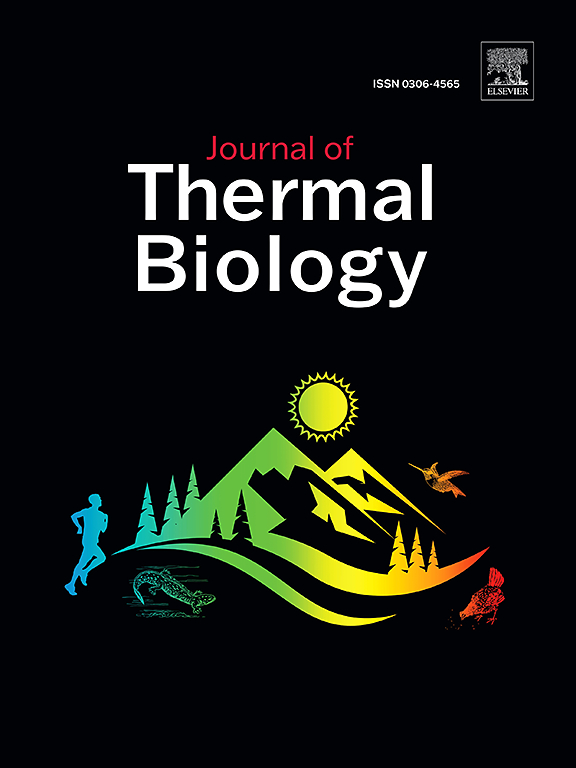Individual variation in diurnal body temperature and foraging activity in overwintering black-capped chickadees (Poecile atricapillus)
IF 2.9
2区 生物学
Q2 BIOLOGY
引用次数: 0
Abstract
Small birds in winter can mitigate energetic shortfalls via increases in foraging and/or via controlled reductions in metabolic rate and body temperature (torpor). The ability to both increase foraging and use torpor during the day could have profound implications for an individual's daily energy budget and overwinter survival. Trade-offs between foraging efficiency and daytime torpor use may exist but have not been explicitly investigated. Here, we investigated the presence of within- and among-individual correlations between daytime body temperature (Tb, a proxy for torpor use) and foraging in overwintering black-capped chickadees (Poecile atricapillus). Using temperature-sensing passive integrated transponder tags, we measured daytime Tb and foraging in 20 free-living chickadees over 49 days in a single winter (January–February). Chickadees generally exhibited Tb around normothermic levels with an average Tb during visits to the feeder of 41.7 °C, though Tb ranged between 25.0 and 44.9 °C. Chickadees exhibited moderately lower daytime Tb, shorter time intervals between successive feeder visits (IVI), and increased feeder visits as ambient temperature decreased. However, within individuals there was only evidence of a weak positive correlation between visit Tb and IVI, and no correlation between daily feeder visits and daily mean visit Tb. We found that visit Tb, daily mean visit Tb, and daily feeder visits were repeatable, while IVI was not. Sex did not explain a significant amount of variation in total daily feeder visits or daytime Tb, nor was there evidence of among-individual correlations between daily mean visit Tb and daily feeder visits. Our results suggests that chickadees may independently regulate foraging and diurnal Tb. Overall, our study provides insights into how small birds in winter can use multiple strategies to overcome energetic challenges. Future studies investigating diurnal torpor and its integration with other strategies are needed to further elucidate how small birds survive harsh winter conditions.
越冬黑冠山雀(Poecile atricapillus)昼夜体温和觅食活动的个体差异。
小型鸟类在冬季可以通过增加觅食和/或通过控制降低代谢率和体温(冬眠)来缓解能量不足。在白天增加觅食和冬眠的能力可能对个体的日常能量预算和越冬生存有着深远的影响。觅食效率和日间冬眠之间的权衡可能存在,但尚未明确调查。在这里,我们研究了越冬黑冠山雀(Poecile atricapillus)日间体温(Tb,冬眠使用的代理)与觅食之间的个体内部和个体之间的相关性。利用温度传感被动集成应答器标签,我们在一个冬季(1 - 2月)的49天内测量了20只自由生活的山雀的日间Tb和觅食情况。山雀通常在恒温水平附近表现出结核,在访问喂食器时平均结核温度为41.7°C,尽管结核温度在25.0至44.9°C之间。山雀表现出较低的日间结核,较短的连续喂食间隔时间(IVI),并随着环境温度的降低而增加喂食次数。然而,在个体内部,只有证据表明访问结核病和IVI之间存在微弱的正相关关系,每日喂食者访问与每日平均访问结核病之间没有相关性。我们发现访问Tb、每日平均访问Tb和每日喂食器访问是可重复的,而IVI则不是。性别不能解释总每日喂食量或日间结核病的显著差异,也没有证据表明每日平均喂食量和每日喂食量之间存在个体相关性。我们的研究结果表明,山雀可能独立调节觅食和日活动。总的来说,我们的研究为鸟类在冬季如何使用多种策略来克服能量挑战提供了见解。未来的研究需要调查昼夜冬眠及其与其他策略的结合,以进一步阐明小型鸟类如何在严酷的冬季条件下生存。
本文章由计算机程序翻译,如有差异,请以英文原文为准。
求助全文
约1分钟内获得全文
求助全文
来源期刊

Journal of thermal biology
生物-动物学
CiteScore
5.30
自引率
7.40%
发文量
196
审稿时长
14.5 weeks
期刊介绍:
The Journal of Thermal Biology publishes articles that advance our knowledge on the ways and mechanisms through which temperature affects man and animals. This includes studies of their responses to these effects and on the ecological consequences. Directly relevant to this theme are:
• The mechanisms of thermal limitation, heat and cold injury, and the resistance of organisms to extremes of temperature
• The mechanisms involved in acclimation, acclimatization and evolutionary adaptation to temperature
• Mechanisms underlying the patterns of hibernation, torpor, dormancy, aestivation and diapause
• Effects of temperature on reproduction and development, growth, ageing and life-span
• Studies on modelling heat transfer between organisms and their environment
• The contributions of temperature to effects of climate change on animal species and man
• Studies of conservation biology and physiology related to temperature
• Behavioural and physiological regulation of body temperature including its pathophysiology and fever
• Medical applications of hypo- and hyperthermia
Article types:
• Original articles
• Review articles
 求助内容:
求助内容: 应助结果提醒方式:
应助结果提醒方式:


